Social Protection
Context
The State of the World’s Cash 2020 report found:
- Working with, through and alongside social protection systems is now considered key to strengthening the humanitarian-development nexus and humanitarians are increasingly active in this space
- Practitioners find that the three biggest challenges to effective linkages are: (i) lack of coordination between the actors involved, (ii) social protection systems are not designed to respond to crises, (iii) humanitarian practitioners lack expertise in social protection
- Critically, there is no ‘one size fits all’ solution to linking CVA and social protection. Trade-offs between efficiency, effectiveness, accountability, and sustainability must be considered to ensure the best outcomes for people living in crisis and depends on context, existing systems, and timeframe. Linking will not always be appropriate and social protection systems may not meet all needs. In many contexts, in the short to medium term at least, humanitarian programming will be required to fill gaps.
Current Priorities
The CALP Network has invested intensely in this thematic area over the last few years. We will continue to work closely with the SPIAC-B Working group on linking humanitarian (cash) assistance and social protection (formerly the Grand Bargain Sub-Workstream on Social Protection) and with the SocialProtection.org platform and the Online Community Social Protection in Crisis Contexts to develop evidence, produce capacity building materials and provide technical support to coordination actors.
Community of Practice
SocialProtection.org hosts a dynamic and collaborative online community of practice (CoP) bringing together individuals from diverse backgrounds interested in expanding social protection in crisis-prone areas. The CoP offers a space to exchange documents, insights, and news in order to progress and learn together. Its inclusive and member-led approach offers organisations and individual members a forum to increase learning and outreach, facilitating the exchange of experiences and expanding knowledge. A discussion group hosted by dgroups.org complements these activities by connecting users rapidly via email.
SPACE
There are a wealth of relevant resources from ‘Social Protection Approaches To Covid-19: Expert Advice’ (SPACE) published in the CALP library.
Featured content

Linking Social Protection and Humanitarian Cash and Voucher Assistance
Report
There is a growing momentum and body of work around the idea of developing stronger links between humanitarian cash and voucher assistance (CVA) and social protection (SP). This Briefing Paper for the CALP Network, based on a literature review, a survey, and interviews, is intended to inform the CALP Network’s overall approach in this area, and subsequently its capacity building and...

Linking Social Protection and Humanitarian Cash
Blog Post
The case for social protection to help people cope with shocks has always been clear and never more obvious than during the current Covid-19 crisis. These issues are currently playing out in real time as governments, donors and aid agencies scramble to find ways to get more help to more people to cope with the economic consequences of illness and lockdown. As the virus starts to take hold in...

Linking Social Protection and humanitarian cash and voucher assistance (CVA) – what do we really know and where to start? Findings from the CALP Network commissioned high level briefing paper at the time of COVID-19
Webinar
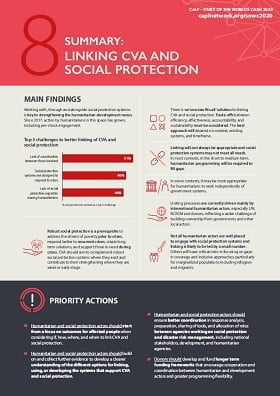
State of the World’s Cash 2020 Chapter 8 summary: Linking CVA and social protection
Report
Longstanding efforts to strengthen links between humanitarian CVA and social protection have been accelerated by the COVID-19 pandemic, with significant progress since the last report. CVA should aim to complement robust social protection systems where they exist and contribute to their strengthening where they are weak or early-stage. This chapter asks: ‘What opportunities and challenges...
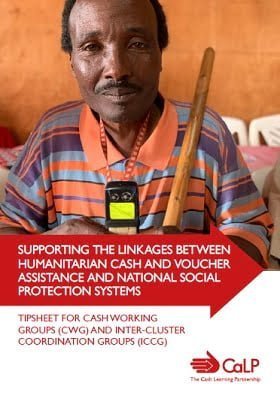
Supporting the Linkages Between Humanitarian Cash and Voucher Assistance and National Social Protection Systems
Report
This tipsheet aims to support country-level coordination efforts to strengthen the engagement between humanitarian coordination groups that implement cash and voucher assistance (CVA) and existing social
protection or disaster risk reduction coordination actors and groups. In particular, it seeks to offers inter-cluster and cash working group coordinators simple practical tips for engaging...
Case Studies

Linking CVA and Social Protection in the MENA Region – Crib sheet
Report
Building linkages between humanitarian cash and voucher assistance (CVA) and social protection (SP) has become an increasingly prominent topic over the past five years and the Middle East and North Africa (MENA) region has been at the centre of this evolution. The objective of this resource set (the crib sheet and 3, soon to be 6, regional case studies) is to ensure that the CALP Network...
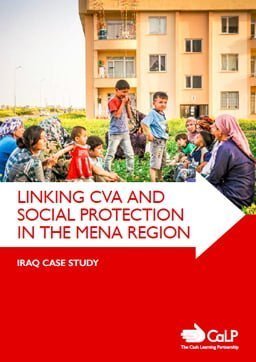
Linking CVA and Social Protection in the MENA Region – Iraq Case Study
Report
Building linkages between humanitarian cash and voucher assistance (CVA) and social protection (SP) has become an increasingly prominent topic over the past five years and the Middle East and North Africa (MENA) region has been at the centre of this evolution. The objective of this resource set (the crib sheet and 3, soon to be 6, regional case studies) is to ensure that the CALP Network...

Linking CVA and Social Protection in the MENA Region – Lebanon Case Study
Report
Building linkages between humanitarian cash and voucher assistance (CVA) and social protection (SP) has become an increasingly prominent topic over the past five years and the Middle East and North Africa (MENA) region has been at the centre of this evolution. The objective of this resource set (the crib sheet and 3, soon to be 6, regional case studies) is to ensure that the CALP Network...
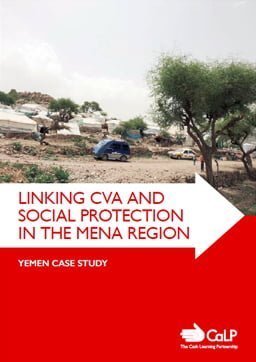
Linking CVA and Social Protection in the MENA Region – Yemen Case Study
Case Study
Building linkages between humanitarian cash and voucher assistance (CVA) and social protection (SP) has become an increasingly prominent topic over the past five years and the Middle East and North Africa (MENA) region has been at the centre of this evolution. The objective of this resource set (the crib sheet and 3, soon to be 6, regional case studies) is to ensure that the CALP Network...

Linking Cash and Voucher Assistance (CVA) and Social Protection – Occupied Palestinian Territories (OPT): Country Summary
Report
This country summary is part of a larger resource set, providing practitioners with examples of different approaches to linking CVA
and social protection.
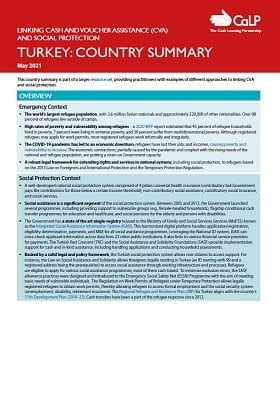
Linking Cash and Voucher Assistance (CVA) and Social Protection – Turkey: Country Summary
Report
This country summary is part of a larger resource set, providing practitioners with examples of different approaches to linking CVA
and social protection.
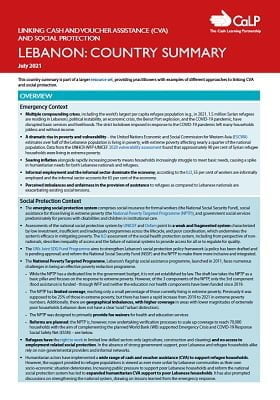
Linking Cash and Voucher Assistance (CVA) and Social Protection – Lebanon: Country Summary
Report
This country summary is part of a larger resource set, providing practitioners with examples of different approaches to linking CVA
and social protection.
Thematic lead
Latest
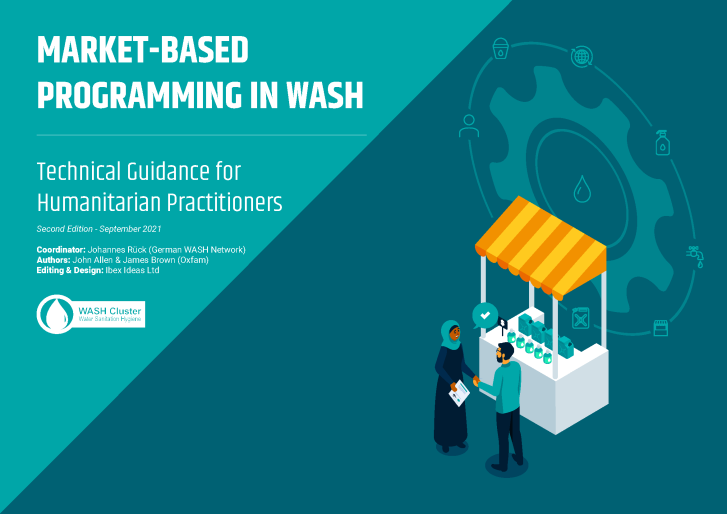
Market-Based Programming in Wash – Technical guidance for humanitarian practitioners
Guidelines and Tools
The purpose of this document is to provide practical guidance on market-based programming (MBP) in humanitarian WASH responses. This guidance is intended for: Humanitarian WASH practitioners Cash and markets practitioners Humanitarian business support teams supporting WASH programmes WASH Cluster/Sector...
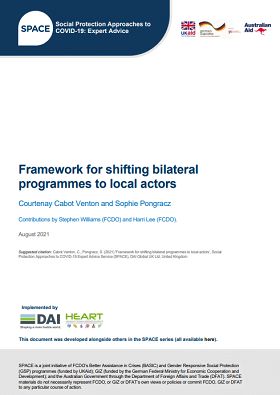
SPACE Framework for shifting bilateral programmes to local actors
Guidelines and Tools
This document presents an initial framing developed to support analysis of separation of functions, Value for Money and risk, to help facilitate a shift from UN/INGO led programmes, to locally-led models that draw on the complementarities between UN, INGO and LNO key strengths. It also reports on the...

SPACE Direct support to local actors: considerations for donors
Guidelines and Tools
The COVID-19 crisis has highlighted the critical role of local actors, including governments, and local and national NGOs, in the design and delivery of programming. Movement restrictions and a rapid scale-up of humanitarian and social protection assistance to new populations have driven a greater focus...
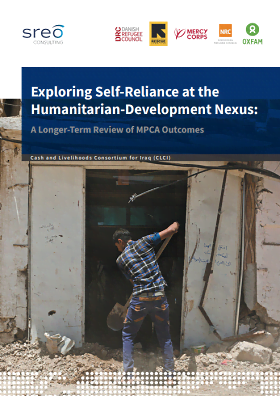
Exploring Self-Reliance at the Humanitarian-Development Nexus: A Longer-Term Review of MPCA Outcomes
Report
Multi-Purpose Cash Assistance (MPCA) is provided to extremely socio-economically vulnerable individuals to alleviate financial hardship. In Iraq, MPCA is intended to act as temporary consumption support so that households may eventually be linked with social protection assistance or return to...
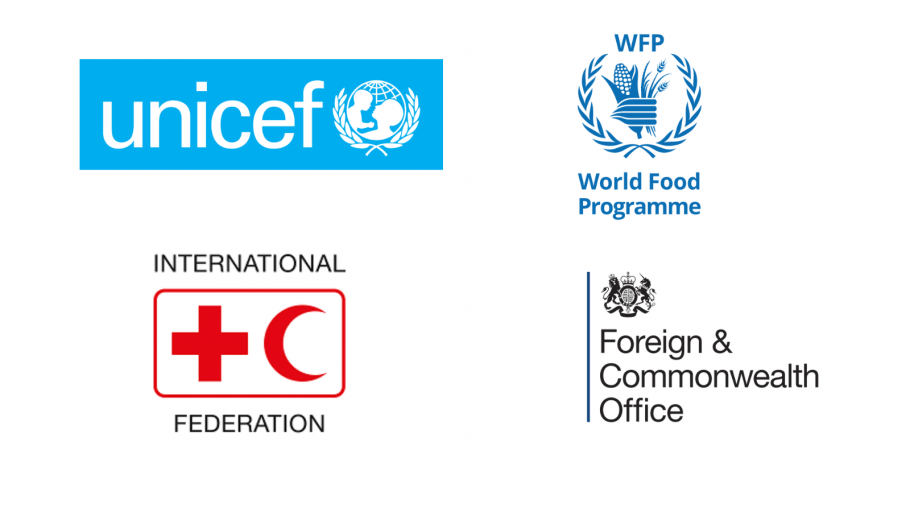
Changing the mindset – turning theory into practice: Incorporating gender-sensitivity into linked humanitarian cash and social protection interventions
Members event
This is one of a series of webinars organised by the Grand Bargain Cash Sub Group, co-led by IFRC, UNICEF and FCDO to engage humanitarian actors with social protection by exploring the linkages between the two agendas and the design and implementation of Cash and Voucher Assistance (CVA).

We Don’t Do a Lot for Them Specifically
Report
Cash based assistance is a large part of government and NGO responses to social protection needs during the COVID-19 crisis. But is this assistance reaching people with diverse SOGIESC (aka LGBTIQ+ people). There are clear needs, borne of systemic discrimination, including loss of informal sector work,...

We Don’t Do a Lot for Them Specifically – Quick Guide
Report

How to promote better nutrition through social assistance – A guidance note
Guidelines and Tools
This guidance is intended to inform the design or adaptation of the following social assistance interventions to make them more nutrition-sensitive (see Box 1): cash transfers, cash-plus, in-kind transfers, school feeding, and public works programmes.

CALP Online: Core CVA Skills for Programme Staff Course
Course
Do you aim to continually develop your professional skills around Cash and Voucher Assistance (CVA)? The CALP Network's online course will strengthen your CVA expertise and your ability to design and implement high-quality programming.

World Food Programme Strategy for Support to Social Protection
Policy paper
In July 2021 WFP launched its Strategy for Support to Social Protection. It explains how WFP will contribute to the development of high quality national social protection systems and programmes in contexts of food insecurity, as a complement to its work responding directly to food security-related...

Linking Cash and Voucher Assistance (CVA) and Social Protection – Lebanon: Country Summary
Report
This country summary is part of a larger resource set, providing practitioners with examples of different approaches to linking CVA
and social protection.
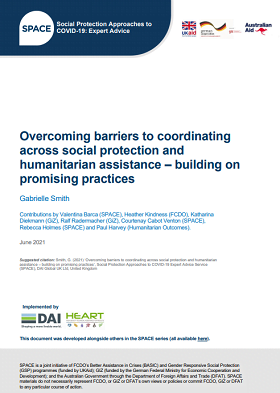
SPACE Overcoming barriers to coordinating across social protection and humanitarian assistance – building on promising practices
Policy paper
The importance of strong coordination between actors preparing, designing and implementing shock responses is well accepted. This has been highlighted specifically concerning shock responsive social protection (SRSP) as well as linking humanitarian action and social protection (HA-SP). However, despite...

SPACE Deciding when and how to link humanitarian assistance and social protection: guidance and tools for response analysis
Policy paper
This short paper presents two complementary ‘Tools’ to guide thinking and decisionmaking on humanitarian programme design, providing the basis for conducting a comprehensive response analysis to inform decisions on linking HA-SP. These can be used to determine the likely feasibility and...
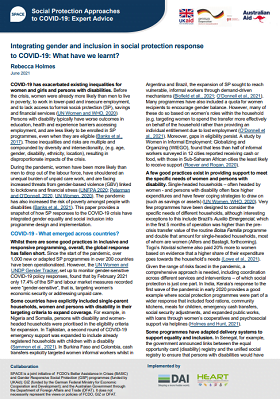
Integrating gender and inclusion in social protection response to COVID-19: What have we learnt?
Policy paper
COVID-19 has exacerbated existing inequalities for women and girls and persons with disabilities. During the pandemic, women have been more likely than men to drop out of the labour force, have shouldered an unequal burden of unpaid care work, and are facing increased threats from gender-based violence...
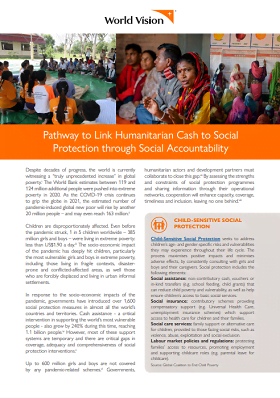
Transfers with Impact – Pathway to Link Humanitarian Cash to Social Protection through Social Accountability
Policy paper
In response to the socio-economic impacts of the pandemic, governments have introduced over 1,600 social protection measures in almost all the world’s countries and territories. Cash assistance – a critical intervention in supporting the world’s most vulnerable people – also grew by 240% during...

CVA for Child Protection Outcomes: Case study from Cambodia
Video
Save the Children Cambodia and seven partner organizations are working to improve households’ ability to care for their children and achieve positive child protection outcomes. With support from USAID Cambodia and European Union in Cambodia, FCF|REACT is providing monthly cash transfers and supporting...

SPACE What are future financing options for shock responsive social protection? (Summary Brief)
Policy paper
This paper, and the longer Technical Primer that accompanies it, are designed to inform discussions around financing shock-responsive social protection (SRSP). It starts by clarifying terms and providing a framing to guide approaches to SRSP financing. It then provides a high-level overview of current and...
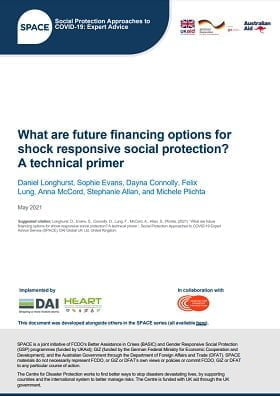
SPACE Gender and Social Protection in the COVID-19 Economic Recovery: Opportunities and Challenges
Policy paper
This paper analyses the potential contribution of social protection to a gender-transformative economic recovery over the medium term, defined as running from the present to the end of 2022. It builds on the existing Social Protection Approaches to COVID-19 Expert (SPACE) advice publication; SPACE Social...

What are future financing options for shock responsive social protection? A technical primer
Guidelines and Tools
This paper aims to advance these discussions in a number of ways. As ‘financing for SRSP’ is understood differently by different people, it starts by providing greater clarity on what this term constitutes, and its relation to disaster risk finance. It acknowledges the broad potential remit of...

Social protection and climate change: scaling up ambition
Policy paper
Social protection can be a strategic tool for climate risk management and provides an important answer to the current calls for climate action and for increased resilience as we recover from COVID-19. The Paris Agreement demands rapid action to keep the average temperature from rising above 1.5 degrees,...

